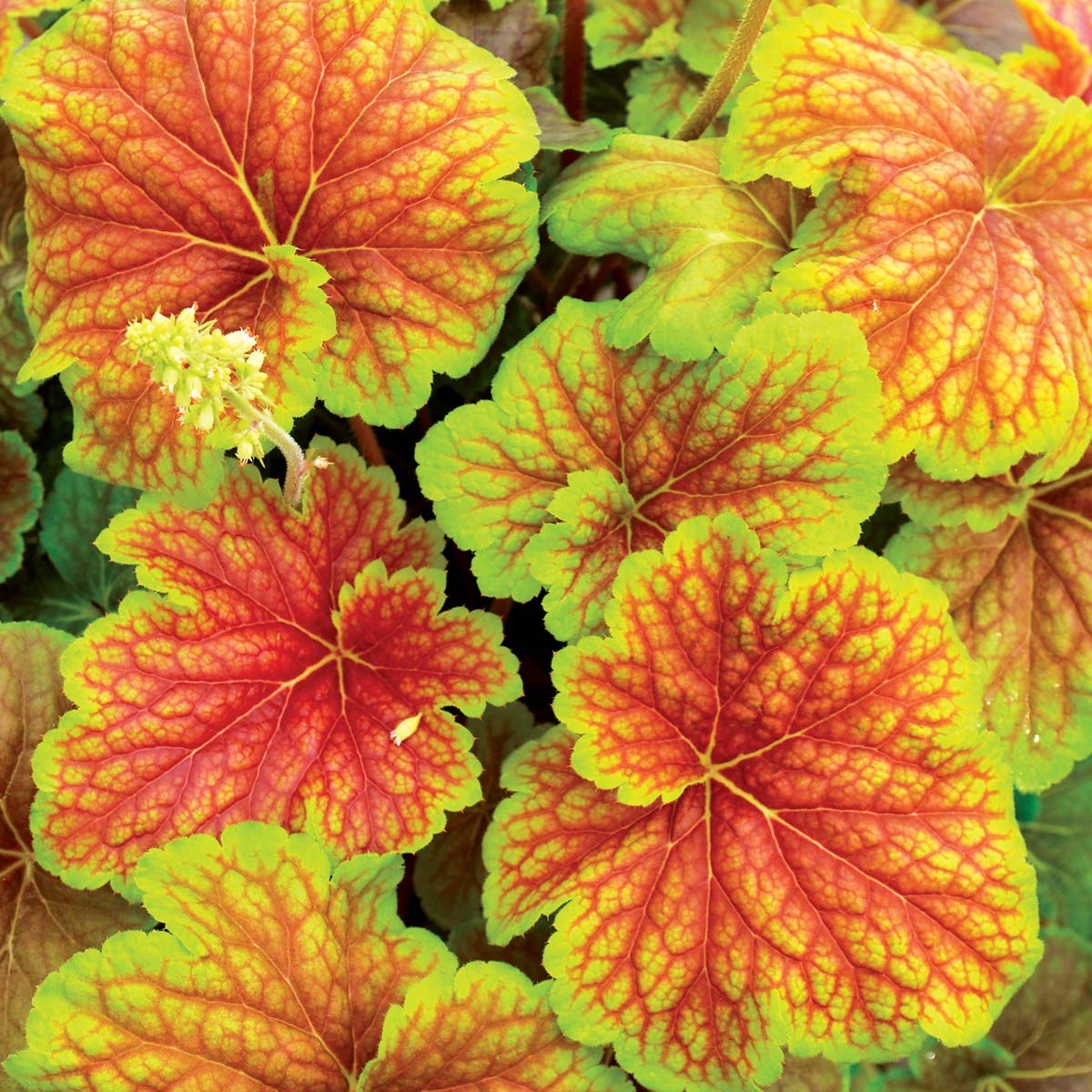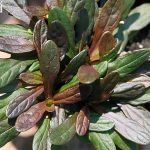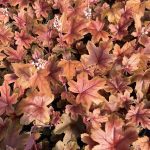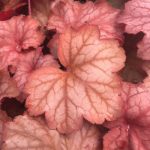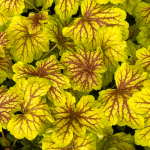Heuchera, Delta Dawn
Price range: $7.99 through $14.99
Plant, Zone 4+
Discount per quantity
| Quantity | 3 - 8 | 9 - 14 | 15+ |
|---|---|---|---|
| Price | Price range: $7.75 through $14.54 | Price range: $7.51 through $14.09 | Price range: $7.19 through $13.49 |
| % Discount | 3% | 6% | 10% |
Description
Heuchera ‘Delta Dawn’: The Golden Glow Your Garden Has Been Waiting For
Welcome to the World of ‘Delta Dawn’
Every garden needs a touch of magic, and Heuchera ‘Delta Dawn’ brings that magic day after day. We are talking about a compact, hardy plant that glows like sunrise, then shifts its colors as the seasons turn. In other words, it is a living mood ring for your shady beds and bright containers. ‘Delta Dawn’ belongs to the coral bells family. That means bold foliage, tidy mounds, and airy flower stems that sway in a summer breeze. But most of all, it means year-round cheer that asks for very little in return.
A Snapshot of Its Spark
- Botanical name: Heuchera ‘Delta Dawn’
- Plant family: Saxifragaceae
- Hardiness: USDA Zones 4 through 9
- Mature size: 8-10 inches tall, 14-16 inches wide
- Foliage colors: Golden yellow with warm red veins in spring; soft chartreuse edged with ruby centers in summer; flashes of amber and peach in fall
- Flowers: Creamy bell-shaped blooms on slender 18-inch stems, late spring to early summer
- Light: Morning sun or bright shade; dappled light all day is ideal
- Soil: Rich, well-drained, slightly acidic to neutral
- Special perks: Evergreen in mild winters, deer-resistant foliage, pollinator-friendly blooms
Instead of blending in, ‘Delta Dawn’ shines like a miniature sunrise. One plant in a pot lights up a porch. A drift along a path turns dull corners into golden rivers. After more than a decade in home gardens, it keeps winning hearts because it stays bright even when nothing else does.
Why ‘Delta Dawn’ Earns a Prime Spot
- Color That Never Quits
Leaves open chartreuse-gold with vivid red veins each spring. By midsummer the outer edges mellow to soft lime while the centers glow warm coral. In fall, the whole crown blushes with peach and amber. We enjoy a four-season color wheel without swapping plants. - Low-Key Maintenance
Once established, ‘Delta Dawn’ needs only moderate moisture, a yearly scoop of compost, and a gentle trim of old flower stems. No constant pruning. No endless feeding. - Small Space Champion
Tiny city balcony? Narrow shade border? Mixed planter on the steps? This tidy mound slides right in. Its roots stay shallow, so it rarely tangles with nearby shrubs. - Pollinator Party
While we adore the foliage, bees and hoverflies adore the flowers. Those slender stems lift dainty bells filled with nectar, turning even quiet corners into buzzing cafés. - Deer and Rabbit Reluctant
Foliage contains natural compounds that most grazing critters dislike. We rest easy knowing delicate leaves stay intact.
Planning the Perfect Home
Light Levels Made Simple
- Cool regions (Zones 4-6): Morning sun plus afternoon shade works best.
- Warm regions (Zones 7-9): Bright dappled shade all day is safer. A couple of gentle sunrise rays are fine, but fierce afternoon sun may scorch tender gold.
Soil and Drainage
Heucheras hate wet feet. Good drainage is key. Work in leaf mold, fine bark, or compost to loosen clay. Raised beds and wide containers help when native soil stays soggy.
Spacing and Companions
Set each crown so the junction of leaf and root stays at ground level. Space plants 12-15 inches apart for a seamless carpet. Pair with:
- Blue hostas for cool contrast
- Purple heucheras like ‘Forever Purple’ for drama
- Ferns and carex sedges for soft texture
- Spring bulbs that pop up through the foliage, then vanish under summer leaves
Planting Step by Step
- Timing: Early spring or early fall when soil is workable and mild.
- Digging: Make a hole twice as wide as the root ball and just as deep.
- Amending: Blend equal parts garden soil, compost, and fine pine bark.
- Setting: Place the plant so the crown sits flush with the soil line. Back-fill, then press gently.
- Watering: Soak thoroughly to settle roots.
- Mulching: Spread a two-inch layer of shredded leaves, keeping mulch an inch away from the crown to prevent rot.
Use your hand—not the shovel handle—to gauge moisture the first month. Keep soil evenly damp but never saturated.
Everyday Care Made Simple
Water
- New plants: Water twice a week during the first six weeks, tapering as roots anchor.
- Established plants: One deep soak each week in dry spells. Morning water keeps leaves dry by nightfall.
Feeding
A spring dressing of compost or a balanced slow-release fertilizer keeps leaves glowing. Avoid high-nitrogen spikes that can soften tissues and fade color.
Pruning
Snip spent flower stalks at the base once blooms fade. In late winter, remove any ragged foliage to invite fresh spring growth. Avoid cutting into the woody crown.
Dividing
After three to four seasons, clumps may thin in the center. Early spring division renews vigor:
- Lift the entire plant with a fork.
- Slice the crown into three sections, each with healthy roots and buds.
- Replant divisions at the original depth, water well, and watch new growth explode.
Seasonal Playbook
| Season | To-Do List | Visual Rewards |
|---|---|---|
| Spring | Clean old leaves, add compost, plant companions | Chartreuse leaves streaked with red |
| Summer | Check water weekly, dead-head spent blooms | Soft lime edges with ruby hearts, airy flower wands |
| Fall | Top-dress with compost, divide if needed, tuck in bulbs | Leaves shift to glowing peach and gold |
| Winter | Brush off heavy snow, avoid salty melt runoff | Evergreen tufts hold color on mild days |
Troubleshooting the Few Hiccups
Leaf Scorch
Brown edges appear in strong sun or drought.
Move containers to shade or add a shade cloth. Deep soak once, then keep soil evenly moist.
Root or Crown Rot
Leaves collapse and crown feels mushy.
Soil stayed too wet. Lift plant, trim rotten roots, replant in sharper drainage, or shift to a pot with fresh mix.
Vine Weevil Larvae
Leaves wilt despite moist soil; roots show crescent-shaped bites.
Drench soil with beneficial nematodes in mid-spring and again in late summer. Remove severely damaged plants and replant with fresh soil.
Rust or Leaf Spots
Small orange or brown dots on undersides.
Improve airflow, water at soil level, and remove infected leaves. An organic copper soap spray can halt spread.
Design Ideas That Shine
Golden Pathway Edging
Outline a shady flagstone walk with a ribbon of ‘Delta Dawn’. The low mounds hug the stones, guiding feet while brightening dim corners.
Container Stars
A simple terracotta bowl filled with three ‘Delta Dawn’ crowns becomes a glowing table centerpiece. Add ivory trailing bacopa or blue lobelia for contrast, and you have living art all season.
Mixed Shade Border
Layer from back to front: tall ostrich fern, medium hosta ‘Halcyon’, Heuchera ‘Delta Dawn’, and dwarf white astilbe. The result? Texture, color, and bloom in a short four-foot strip.
Autumn Fire Feature
Plant ‘Delta Dawn’ beside Japanese forest grass (Hakonechloa macra ‘Aureola’) and purple autumn fern. As days shorten, gold, peach, and burgundy blend into a sunset tapestry.
Propagation and Sharing Joy
Heucheras divide easily, and a single mature plant can yield three strong starts. After more than two seasons in a favorite spot, you may find yourself slicing clumps and gifting glowing pups to friends. Each division is already a rooted plant, ready to thrill another garden.
Quick Division Guide
- Choose a cool morning in early spring.
- Water the plant well the day before.
- Use a digging fork to lift the whole root ball.
- With a sharp knife or spade, cut through the crown.
- Trim away any dead center.
- Replant divisions right away, keep moist, and watch new leaves unfurl.
Greener Gardening With ‘Delta Dawn’
- Soil Health: The dense leaf canopy shades soil, limiting weeds and preserving moisture.
- Wildlife Support: Early summer flowers offer nectar before many perennials bloom.
- Water Savings: Mature plants handle short dry spells thanks to a fibrous root mat.
- Long Life: Rather than replanting annuals every spring, we keep this perennial glowing year after year, saving both resources and money.
Tales From Fellow Gardeners
“One ‘Delta Dawn’ became five after just three years, and every piece took in my clay soil once I added leaf mold.” — Amelia in Ohio
“I tuck mine under a hydrangea, and even in July heat the leaves stay bright. The red centers almost sparkle.” — Carlos in Texas
“Deer walked past it and ate the hostas instead. Enough said.” — Nora in Vermont
Real voices remind us that simple steps—rich soil, gentle shade, steady moisture—unlock the best color.
Often-Missed Tips That Make a Big Difference
- Lift crowns slightly if heavy leaf mulch settles too thick in winter. Airflow prevents rot.
- Rotate containers a quarter turn each week. Even light exposure leads to even color.
- Trim flower stems after half the bells fade. New blooms keep rising when energy is not wasted on old seed heads.
- Rinse leaves with a fine spray after high pollen days. Clean foliage dazzles more.
Encouragement for New Gardeners
We all start somewhere, and ‘Delta Dawn’ is a forgiving coach. Miss a watering? Leaves might droop, yet bounce back after a drink. Forget to feed? Colors stay bright, just a touch softer. Unlike fussier shade plants, this heuchera greets beginners with open arms and vivid hues.
A Dawn of Endless Color
When we choose plants, we look for beauty, resilience, and joy. Heuchera ‘Delta Dawn’ offers all three in one compact package. From spring’s golden blush to autumn’s peach glow, it writes a lively story across our beds and pots. We gain a plant that looks tender yet stands tough, one that brightens shadows and welcomes bees, one that invites new gardeners and rewards seasoned hands.
So let’s set the stage. Find that shady nook or lonely container. Loosen the soil, tuck in a crown, water well, and step back. The dawn will rise every day in miniature, right at our feet, brightening our lives season after season.
Additional information
| Weight | N/A |
|---|---|
| Options | Starter Plug, 4 in. (16.9 fl. oz.) Pot |

